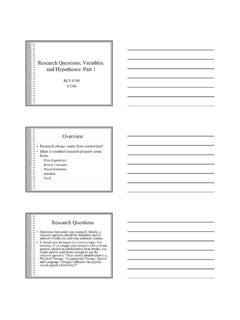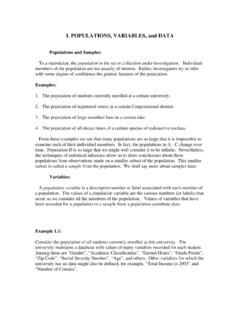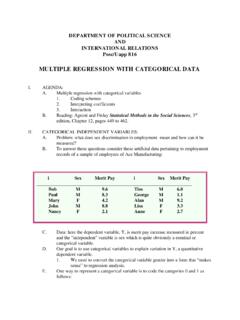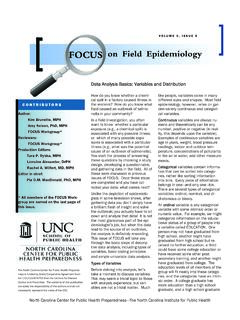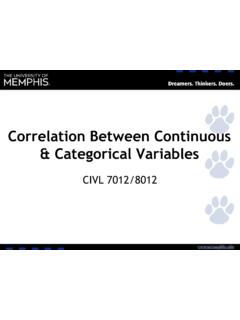Transcription of Categorical and discrete data. Non-parametric tests
1 Categorical and discrete data. Non-parametric tests Dr. Hemal Pandya Learning Objectives Develop the need for inferential techniques that require fewer, or less stringent, assumptions than the methods of earlier chapters Introduce nonparametric tests that are based on ranks ( , on an ordering of the sample measurements according to their relative magnitudes) Non-parametric tests : estimate sample differences when the known distribution shapes cannot help, or even confuse Parametric Vs Non-parametric tests Parametric tests : The population mean ( ), standard deviation (s) and proportion (p) are called the parameters of a distribution. tests of hypotheses concerning the mean and proportion are based on the assumption that the population(s) from where the sample is drawn is normally distributed.
2 tests based on the above parameters are called parametric tests . Parametric Vs. Non-parametric tests Non-parametric tests :- There are situations where the populations under study are not normally distributed. The data collected from these populations is extremely skewed. Therefore, the parametric tests are not valid. The option is to use a Non-parametric test. These tests are called the distribution-free tests as they do not require any assumption regarding the shape of the population distribution from where the sample is drawn. These tests could also be used for the small sample sizes where the normality assumption does not hold true. Advantages of Non-parametric tests They can be applied to many situations as they do not have the rigid requirements of their parametric counterparts, like the sample having been drawn from the population following a normal distribution.
3 There can be applications where a numeric observation is difficult to obtain but a rank value is not. By using ranks, it is possible to relax the assumptions regarding the underlying populations. Non-parametric tests can often be applied to the nominal and ordinal data that lack exact or comparable numerical values. Non-parametric tests involve very simple computations compared to the corresponding parametric tests . Disadvantages of Non-parametric tests A lot of information is wasted because the exact numerical data is reduced to a qualitative form. The increase or the gain is denoted by a plus sign whereas a decrease or loss is denoted by a negative sign. No consideration is given to the quantity of the gain or loss.
4 Non-parametric methods are less powerful than parametric tests when the basic assumptions of parametric tests are valid. Null hypothesis in a Non-parametric test is loosely defined as compared to the parametric tests . Therefore, whenever the null hypothesis is rejected, a Non-parametric test yields a less precise conclusion as compared to the parametric test. Difference between Parametric & Non-parametric tests SLIDE 14-5 Nonnormal Distributions - t-Statistic is Invalid 2011 Pearson Education, Inc Distribution-Free tests Distribution-free tests are statistical tests that do not rely on any underlying assumptions about the probability distribution of the sampled population. The branch of inferential statistics devoted to distribution-free tests is called nonparametrics.
5 Nonparametric statistics (or tests ) based on the ranks of measurements are called rank statistics (or rank tests ). Parametric and nonparametric tests of significance Nonparametric testsParametric testsNominaldataOrdinal dataOrdinal, interval,ratio dataOne groupChi squaregoodnessof fitWilcoxonsigned rank testOne group t-testTwounrelatedgroupsChi squareWilcoxon ranksum test,Mann-WhitneytestStudent s t-testTwo relatedgroupsMcNemar stestWilcoxonsigned rank testPaired Student st-testK-unrelatedgroupsChi squaretestKruskal -Wallisone wayanalysis ofvarianceANOVAK-relatedgroupsFriedmanma tchedsamplesANOVA withrepeatedmeasurements Using Statistics The Sign Test The Runs Test - A Test for Randomness The Mann-Whitney U Test The Wilcoxon Signed-Rank Test The Kruskal-Wallis Test - A Nonparametric Alternative to One-Way ANOVA Nonparametric Methods and Chi-Square tests (1)
6 14 The Friedman Test for a Randomized Block Design The Spearman Rank Correlation Coefficient A Chi-Square Test for Goodness of Fit Contingency Table Analysis - A Chi-Square Test for Independence A Chi-Square Test for Equality of Proportions Nonparametric Methods and Chi-Square tests (2) 14 Differentiate between parametric and nonparametric tests Conduct a sign test to compare population means Conduct a runs test to detect abnormal sequences Conduct a Mann-Whitney test for comparing population distributions Conduct a Wilkinson s test for paired differences LEARNING OBJECTIVES 14 After reading this chapter you should be able to: Conduct a Friedman s test for randomized block designs Compute Spearman s Rank Correlation Coefficient for ordinal data Conduct a chi-square test for goodness-of-fit Conduct a chi-square test for independence Conduct a chi-square test for equality of proportions LEARNING OBJECTIVES (2) 14 After reading this chapter you should be able to: Parametric Methods Inferences based on assumptions about the nature of the population distribution Usually.
7 Population is normal Types of tests z-test or t-test Comparing two population means or proportions Testing value of population mean or proportion ANOVA Testing equality of several population means 14-1 Using Statistics (Parametric tests ) Nonparametric tests Distribution-free methods making no assumptions about the population distribution Types of tests Sign tests Sign Test: Comparing paired observations McNemar Test: Comparing qualitative variables Cox and Stuart Test: Detecting trend Runs tests Runs Test: Detecting randomness Wald-Wolfowitz Test: Comparing two distributions Nonparametric tests Nonparametric tests Ranks tests Mann-Whitney U Test: Comparing two populations Wilcoxon Signed-Rank Test: Paired comparisons Comparing several populations: ANOVA with ranks Kruskal-Wallis Test Friedman Test: Repeated measures Spearman Rank Correlation Coefficient Chi-Square tests Goodness of Fit Testing for independence: Contingency Table Analysis Equality of Proportions Nonparametric tests (Continued) Deal with enumerative (frequency counts) data.
8 Do not deal with specific population parameters, such as the mean or standard deviation. Do not require assumptions about specific population distributions (in particular, the normality assumption). Nonparametric tests (Continued) 2011 Pearson Education, Inc Key Ideas Distribution-Free tests Do not rely on assumptions about the probability distribution of the sampled population 2011 Pearson Education, Inc Key Ideas Nonparametrics Distribution-free tests that are based on rank statistics One-sample nonparametric test for the population median sign test Nonparametric test for two independent samples Wilcoxon rank sum test Nonparametric test for matched pairs Wilcoxon signed rank test Key Ideas Nonparametrics Nonparametric test for a completely randomized design Kruskal-Wallis test Nonparametric test for a randomized block design Friedman test Nonparametric test for rank correlation Spearman s test Most of the statistical methods referred to as parametric require the use of interval- or ratio-scaled data.
9 Nonparametric methods are often the only way to analyze nominal or ordinal data and draw statistical conclusions. Nonparametric methods require no assumptions about the population probability distributions. Nonparametric methods are often called distribution-free methods. Nonparametric Methods Nonparametric Methods In general, for a statistical method to be classified as nonparametric, it must satisfy at least one of the following conditions. The method can be used with nominal data. The method can be used with ordinal data. The method can be used with interval or ratio data when no assumption can be made about the population probability distribution. Advantages of Nonparametric tests Used with all scales Easier to compute Developed originally before wide computer use Make fewer assumptions Need not involve population parameters Results may be as exact as parametric procedures 1984-1994 T/Maker Co.
10 Disadvantages of Nonparametric tests May waste information If data permit using parametric procedures Example: converting data from ratio to ordinal scale Difficult to compute by hand for large samples Tables not widely available 1984-1994 T/Maker Co. Non-parametric Pros and Cons Advantages of Non-parametric tests Shape of the underlying distribution is irrelevant - does not have to be normal Large outliers have no effect Can be used with data of ordinal quality Disadvantages Less Power - less likely to reject H0 Reduced analytical sophistication. With nonparametric tests there are not as many options available for analysing your data Inappropriate to use with lots of tied ranks 2011 Pearson Education, Inc Frequently Used Nonparametric tests Sign Test Wilcoxon Rank Sum Test Wilcoxon Signed Rank Test Kruskal Wallis H-Test Spearman s Rank Correlation Coefficient Single Population Inferences Sign Test A common application of the sign test involves using a sample of n potential customers to identify a preference for one of two brands of a product.
